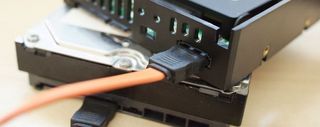Turn your hard drive into a hybrid

Fancy SSD performance with the kind of storage capacity more commonly associated with a traditional hard drive? You've got two choices: either sell your first born to buy a large SSD drive, or take a look at Icy Dock's new SSD Xpander .
The SSD Xpander is a 3.5inch hard disk caddy designed to hold a standard 2.5inch laptop SSD drive. Around the back, though, there's an extra SATA port for daisy chaining a normal 3.5inch hard drive to the Xpander. Once you've connected both SSD and HDD, a second partition is created on the latter and connected to the SSD via an internal RAID interface. The SSD now appears to Windows (or any other OS, since this is a hardware implementation) as double its actual size. Caching technology moves data between the HDD and the SSD to try and ensure that the bits and bytes you need are kept in the faster SSD half of the virtual drive.
It's a little like Intel's Smart Response Technology (SRT) which premièred on recent Z68 motherboards, which can also join an SSD and a hard drive in an unholy union of speed. Only the Xpander theoretically works with any motherboard and system.
The obvious drawback is the same one as is associated with any RAID striping set-up - if one drive fails, you lose data from both. Also, if the caching technology moves data around too much it could end up wearing out the SSD or overloading its garbage collection capabilties . It's also potentially cheaper to look at a native hybrid drive like the Seagate Momentous XT than buying two separate drives for a new build.
Still, the idea of having a large virtual drive capable of SSD speeds is hugely appealing, and gets around the current house keeping problems of what should and shouldn't be installed directly to the SSD when a small capacity one is included in a system. Plus, the Icy Dock SSD Xpander is only £30/$48. Since our review sample of has just turned up in the labs, I'll be able to tell you whether it's any good or not in the next few days.
PC Gamer Newsletter
Sign up to get the best content of the week, and great gaming deals, as picked by the editors.
Most Popular




